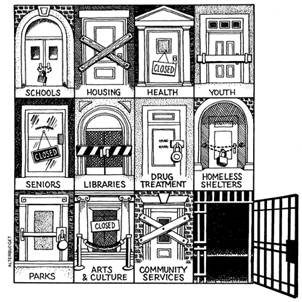Big Cities Continue to Feed the Prison Industrial Complex
 The Justice Policy Institute has a new report that starkly illustrates how our major cities (in this case Washington D.C.) are redirecting resources from support services towards the prison industrial complex.
The Justice Policy Institute has a new report that starkly illustrates how our major cities (in this case Washington D.C.) are redirecting resources from support services towards the prison industrial complex.
In Washington D.C., since 2008, spending on the Metropolitan Police Department and the Office of the Attorney General increased more than 2 percent and 11 percent respectively, while funding for schools, mental health services and housing has dropped. Research shows that investing in front-end services and programs that keep people out of the justice system is more effective at improving public safety and promoting community well-being than law enforcement and incarceration.
Other key report findings include:
* Despite an increasing need for affordable and supportive housing for residents during tough economic times, the budget for the District’s Department of Housing was cut more than 30 percent in the last two years, with the Housing Production Trust Fund losing $42 million in 2008 to $18 million in 2010, a cut of more than 50 percent.
* D.C. has one of the highest rates of homelessness in the country; estimates of the homeless population range from 12,000 to 17,800 over the course of a year. Forty-seven percent of homeless people in D.C. are “chronically homeless.”
* Even though D.C. Public Schools continue to struggle with achieving its goal of providing quality education to every child, spending on education in the District has fallen 17 percent ($170 million) since 2008. Research shows that states that invest more in education have lower crime rates than states that spend less. Wards with the lowest median income and highest percentage of people of color have the lowest math and reading proficiencies and the most people without high school degrees.
* Despite a clear need for mental health services, especially for low-income populations and at-risk children and teens, the city continues to cut funding in this area. The D.C. Department of Mental Health’s budget was cut 17 percent from 2008 to 2010. Over 5,000 D.C. children in need of mental health treatment do not receive it.
* The Department of Parks and Recreation provides vital youth programming and maintains safe spaces for children to play. Yet funding for the Department of Parks and Recreation fell almost 20 percent from 2008 to 2010. These programs are especially valuable to children and teens whose families cannot afford private camps, classes, or after school programs.
This is a terrific concrete example of the warped priorities that many of our big cities and the country overall have. We need a movement to press political leaders to redirect needed resources to the social safety net rather than to the PIC.
